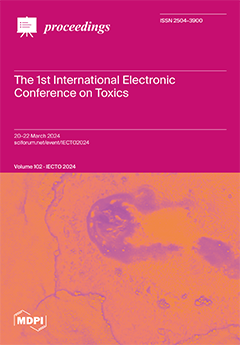Need Help?
Proceedings, 2024, IECTO 2024
The 1st International Electronic Conference on Toxics
Online | 20–22 March 2024
Volume Editor:
Demetrio Raldúa, IDAEA-CSIC, Spain
- Issues are regarded as officially published after their release is announced to the table of contents alert mailing list.
- You may sign up for e-mail alerts to receive table of contents of newly released issues.
- PDF is the official format for papers published in both, html and pdf forms. To view the papers in pdf format, click on the "PDF Full-text" link, and use the free Adobe Reader to open them.
Cover Story (view full-size image):
The 1st International Electronic Conference on Toxics took place online on 20–22 March 2024. This platform connects global researchers to share insights on chemical and material impacts
[...] Read more.
The 1st International Electronic Conference on Toxics took place online on 20–22 March 2024. This platform connects global researchers to share insights on chemical and material impacts on human and environmental health, including new risk assessment approaches. The conference is structured into six main sessions covering Environmental Contaminants and Health, Drugs Toxicity and Safety, Toxicological Mechanisms of Toxicants, Identification and Quantification of Toxicants, Novel Methods in Toxicology Research, and Toxicity Reduction and Environmental Remediation.
Previous Issue
Next Issue
Issue View Metrics
Multiple requests from the same IP address are counted as one view.



